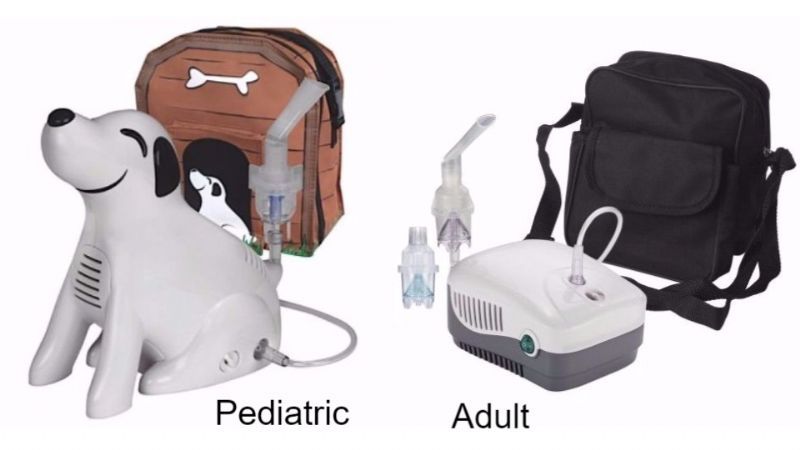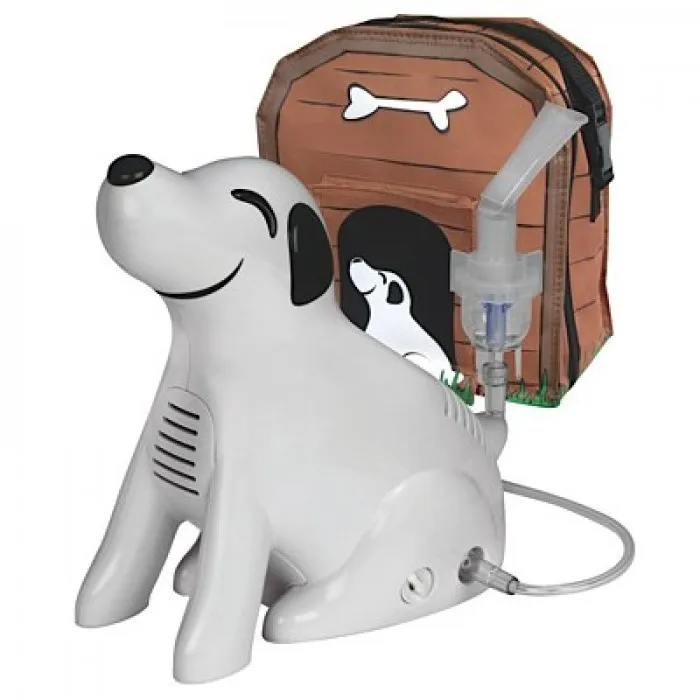 Written by Mike Price, OT
Written by Mike Price, OT
A nebulizer is a drug delivery device that uses compressed air to convert liquid medication into a breathable mist. Available in both electric and battery-operated versions, nebulizers are most commonly used to treat asthma and other breathing conditions.
When using a nebulizer, medication is delivered via a facemask or mouthpiece. A pre-measured amount of the user’s liquid medicine is placed into the nebulizer’s reservoir, and a compressor tube is connected to the nebulizer at one end with the mask or mouthpiece at the other.
The medication is then delivered through the tube and into a mask or mouthpiece using either compression or vibration to convert the medication into a fine mist. The user breathes deeply, and the medication is inhaled directly into the lungs, providing relief from breathing difficulties. Most treatments take no more than ten minutes!

Pediatric nebulizers are designed to deliver breathing medication quickly and efficiently, but also make the experience of using a nebulizer less anxiety-provoking for young children.
Many pediatric nebulizers come in fun shapes and patterns - some in the shape of a friendly animal, others with bright colours the child can interact with while receiving their medication.
Adult nebulizers are more standard in appearance, although some may contain unique features which distinguish one from another.
The choice of nebulizer design is a matter of convenience, and of knowing where and how you are planning to use the nebulizer. Some nebulizers contain compressors which weigh several pounds, while others are small enough to fit in the palm of your hand!
To choose the best product size, first determine if you will be using the nebulizer primarily at home, or if you want the option of being able to take it with you to a friend’s home or on a trip.
Some users with severe asthma find that traveling with a nebulizer is a necessity. If this is the case for you, selecting a nebulizer capable of being carried on active adventures will direct you toward portable models.
Helpful tip: When traveling by airplane, remember to inform TSA of your nebulizer and medication, which you are legally allowed to carry on so long as the device is packed appropriately and all liquid medications are stored in 3 oz. containers.
Nebulizers are designed to deliver medication using several different mechanisms. Here are the three most common designs:
When you are in the midst of an asthma attack, the speed and efficiency with which you receive your medication is crucial. A nebulizer’s capacity to deliver medication can range anywhere from four to eight liters per minute, and specific airflow rates can be found in any nebulizer product description.
Helpful tip: You can enhance this speed by keeping the nebulizer filter clean!
Less of a logistical necessity, and more of a personal preference, is the nebulizer’s noise level.
If you are planning on using your nebulizer at night, perhaps while falling asleep (and particularly with a child), be aware of how the larger the compressor, the louder the sound. For optimal comfort, factor your nebulizer’s noise level in amongst the other considerations you’ll be making as you choose the best nebulizer.
While Rehabmart has a broad selection of top-of-the-line nebulizers, three of them stand out and are worth mentioning here:
.jpg)

.jpg)
Sterilization and cleaning of nebulizer components is very important to ensure user’s get the most out of their products while receiving the best level of treatment. Make sure to follow the manufacturer’s guidelines on how to store items between uses!
Although nebulizer parts are created to last a long time, individuals should always replace any mouthpieces, hoses, or high-contact pieces which are worn down, bent, discolored, or cracked in any way.
Helpful tip: When replacement parts are needed, be sure you’re purchasing them from the same manufacturer, or from one who makes parts that are compatible with your nebulizer unit!
Children and adults with a range of diseases and conditions which impair respiration depend on the breathing treatments they receive via a nebulizer. This includes (but isn’t limited to) adults and children who have the following medical conditions:
For someone living with one the aforementioned conditions, using an inhaler may be beyond their capability, particularly if these user’s lack strength and dexterity in their hands. In these cases, a nebulizer ensures medication is given when needed - even if it’s needed in a hurry, as with a rescue inhaler.
Doctors will often prescribe a nebulizer for young children with frequent colds and upper respiratory illness. This is usually a short-term remedy, unless you and your doctor determine that other problems may be contributing (such as asthma).
Did you know that even babies and toddlers can need a nebulizer? While it’s hard to diagnose an infant with asthma, there are certainly cases where a baby or toddler will need breathing treatment. Many, though, will fight a mask, and not want to use a mouthpiece.
In these unique situations, pacifier nebulizers may be the answer! The pacifier attachment fits onto the mouthpiece, causing infants to naturally close their mouth around the device breathe through their nose. This way, medication is naturally inhaled and carried to the lungs.
Nebulizers may be used to vaporize both long-acting medication and short-acting rescue medication.
Yes, Medicare Part B covers nebulizers and nebulizer medications as Durable Medical Equipment (DME), provided they have been prescribed by your doctor as medically necessary.
In fact, you cannot purchase a nebulizer without a physician’s prescription! Getting a prescription is important not only to complete a purchase, but to submit for Medicare coverage of your device.
Talk to your doctor about questions you have regarding the process of purchasing a nebulizer, and how to ensure proper Medicare coverage.
Nebulizers are typically covered under the Durable Medical Equipment portion of health insurance policies.
However, most insurance companies will require that you purchase your equipment from a particular medical equipment supplier to receive coverage.
Check with your health insurance company to avoid misunderstandings!
For a full range of nebulizer options, visit RehabMart's category page!
Want to learn even more? Keep reading with our article The 5 Best Nebulizers!

Co-Founder of Rehabmart and an Occupational Therapist since 1993. Mike has spent his professional career working in multiple areas of Occupational Therapy, including pediatrics, geriatrics, hand therapy, ergonomics and inpatient / outpatient rehabilitation. Mike enjoys writing articles that help people solve complex therapeutic problems and make better product choices.